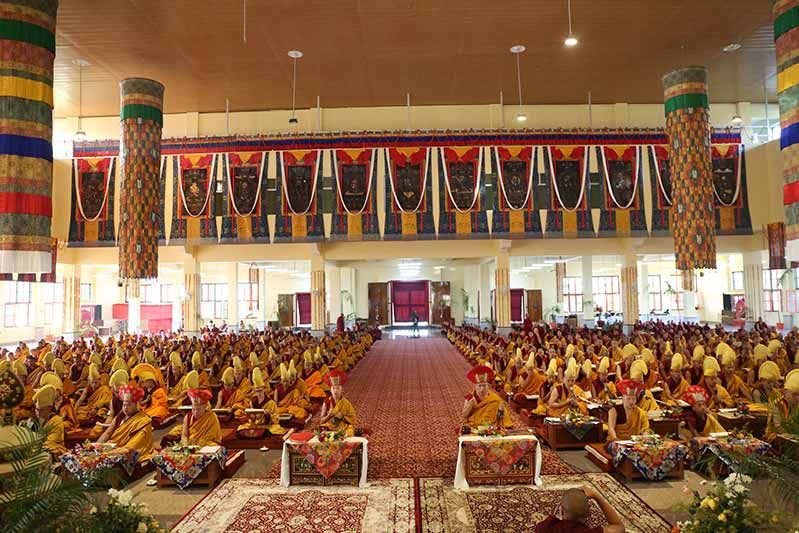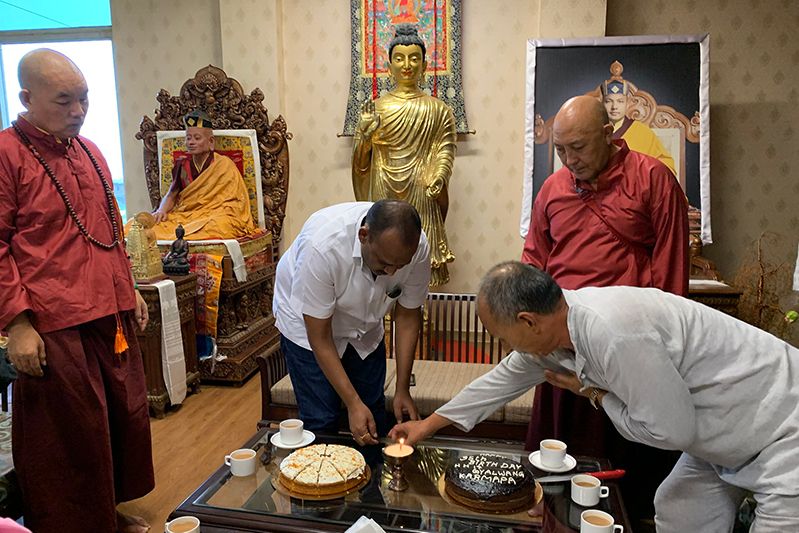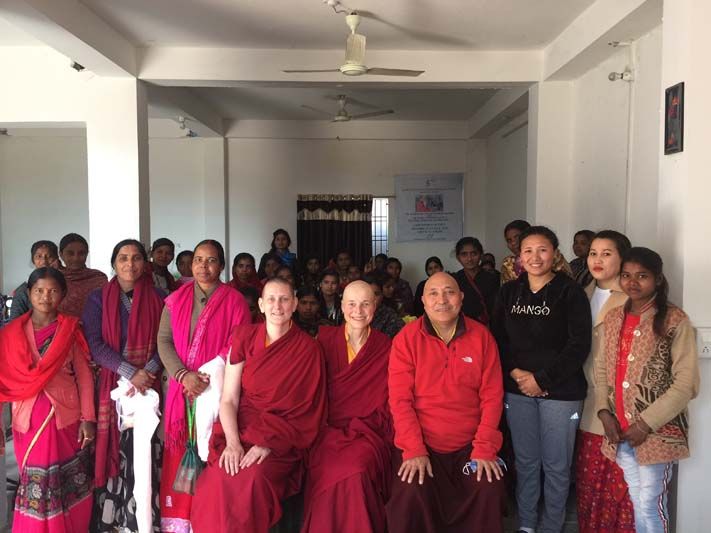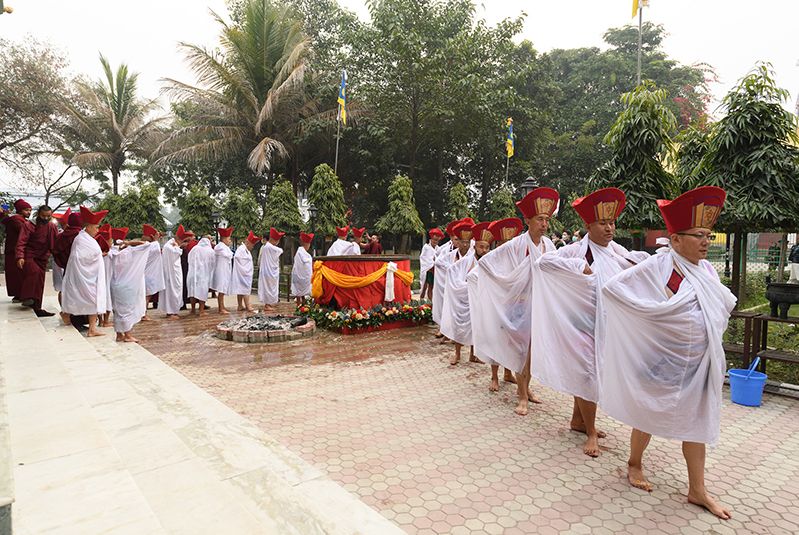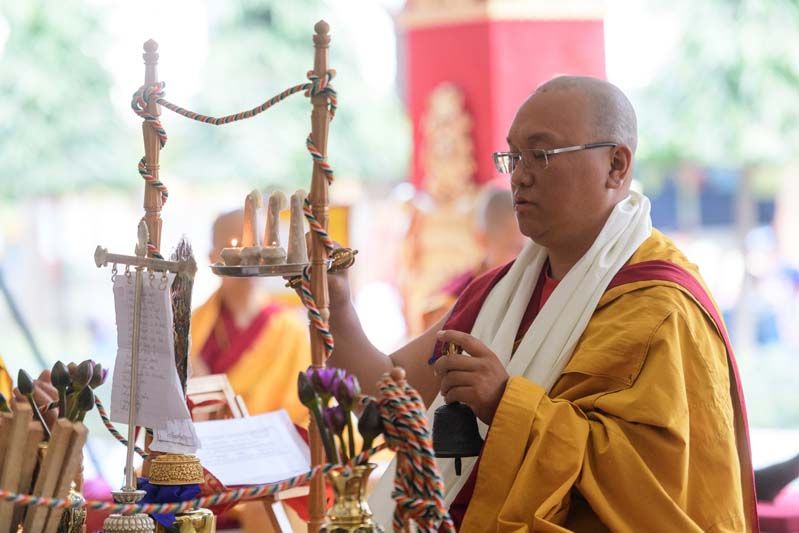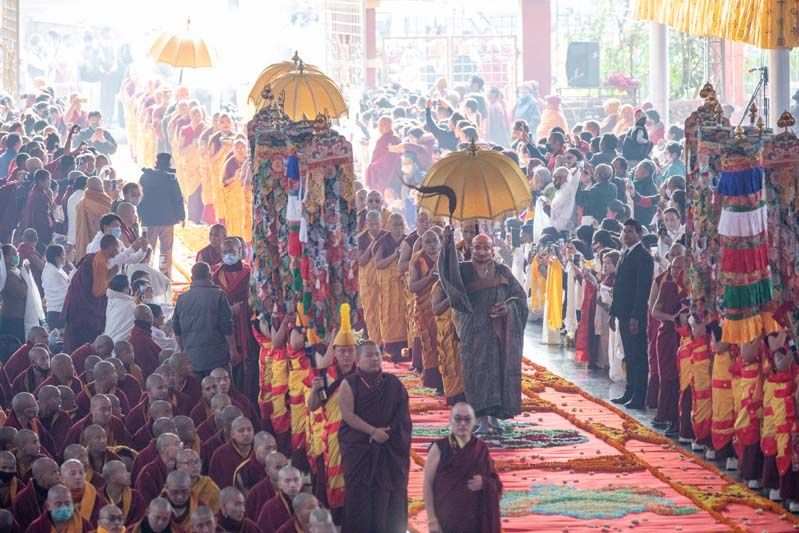Tilopa’s Ganges Mahāmudrā Session Six: Rest in the Unborn Essence
- January 11, 2019
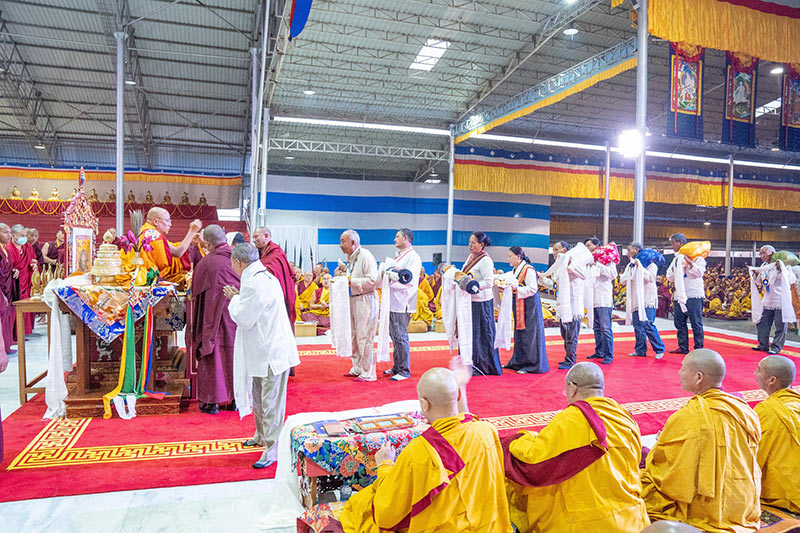
Monlam Pavillion
January 11, 2019
His Eminence Kyabje 10th Sangye Nyenpa Rinpoche began the final and profound teaching on this rarely taught text, The Ganges Mahāmudrā, with the vital reminder that, “We need to bring all beings throughout space to the state of lasting happiness and to the state of completely perfect Buddhahood, and for that reason think that you will practice the profound and vast Dharma properly and listen with the motivation of bodhicitta.”
Having called to mind the lineage of the text, Rinpoche distilled the essence of mahāmudrā with a quote from Milarepa on pure luminosity. Pure luminosity is not in the sphere of words and thought. The yogi rests in the unaltered fundamental nature and remains in equipoise. Rinpoche asked, “And why is that?” As he said, it is because in the nature of mahāmudrā we need to be liberated from any idea that there is meditation or non-meditation.
This ultimate level teaching, however, has to be reached through practicing the seven-point posture of Vairochana. In the beginning, we have to go through the techniques of meditation as methods to manifest the result. These methods are not mahāmudrā. He posed the question, “Isn’t that profound?” He continued, “Meditation, realization, and equipoise – these are not mahāmudrā, they are not the nature, they are not prajñāpāramitā.” Prajñāpāramitā, the nature, is freed from the knots of being bound by the ideas. Until we can liberate from that, we cannot arrive at “letting it be.” If we are unable to let be and stay free from ideas, then no matter how many times we think it is mahāmudrā, it is not. Then it is the conceit of mahāmudrā, but it is not the actual. Until then, it is just ideas. It is contrived meditation and not resting in uncontrived fundamental nature.
Meditation is a thought and non-meditation is also a thought because they both have the nature of rising and ceasing. The fundamental nature, however, is where everything is settled. That is ultimate destination. It must be free of any ideas of arising and ceasing, meditation and non-meditation, and so forth. And, for that reason non-meditation is also a thought. In the nature, there is neither meditation nor non-meditation. Meditation and non-meditation are not two. As Rinpoche emphasized, we need to destroy the conception of there being two so that we can get to the non-dual mind of the yogi. Viewing them as two is the basis of confusion. As long as we have conceptual phenomena that come in pairs we sustain confusion. As Milarepa said, the View and Meditation must be the same. In the ultimate, there is no View and that is certain because we cannot talk about a mentally contrived idea.
Rinpoche joked about the dualistic nature of our minds with a story about tsampa. When we eat tsampa, we desire most expensive kind. We wonder whether this is the sweetest, best tsampa or not. When we make torma, however, we use the smelly tsampa that we would not eat. We say, ‘Oh the tormas do not have any thought.’ After much laughter from the participants, this led to his point that samsara and nirvana are actually the same in flavor. But, we can only come to this level of practice if we can let the six consciousnesses rest naturally. This, Rinpoche stressed, is the view that transcends all views, all meditation, and all conduct. It is the ultimate view.
Throughout the teaching, Rinpoche reminded us that in order to realize this ultimate view, we begin with going forth and following the stages of the path. The View must be connected with scripture and logic. Then, we can practice meditation on egoless-ness. Meditation must be connected with non-fixation and Conduct becomes manifest with experience. The verse says,
Alas! Examine worldly phenomena well.
They cannot withstand analysis, like dreams and illusions.
Dreams and illusions do not exist in actuality.
Therefore, rouse weariness and give up worldly affairs.
Sever all ties of greed and hatred for samsaric objects.
Meditate alone in forest or mountain retreats.
Dwell in the nature of non-meditation.
Rinpoche elaborated that this verse directs us to have revulsion for worldly things. If we are fixated on this life, we are not a practitioner. If we do not “sever all ties of greed and hatred for samsaric objects,” then we are merely stirred up with afflictions. He reminded us of Milarepa who went into the mountains in order to have natural Dharma. The verse from Milarepa says,
In horror of death I took to the mountains, and meditated on the uncertainty and the hour of death. Now capturing the fortress of deathless, unending nature of mind, all fear of death is done and over with.
What this means is that we must keep the idea of impermanence as the immediate focus. There is no certainty to our lives. Just merely saying, ‘Okay, I will do this tomorrow’ shows a disbelief in impermanence because we may not be able to get up tomorrow. We must remember that death is certain and we are longing for freedom.
Rinpoche reminded us how the preliminary practices purify the numerous obscurations of greed and hatred that accumulate in the mind. We have to purify those by prostrating and confessing our misdeeds. Then, these obscurations become thinner. If we have a workable mind, then we can have an idea of improvement. He taught that we need a mind of renunciation for the mind to be workable.
Another crucial aspect is being able to receive the blessings of root lineage gurus. When these blessings enter your heart, then your mind will be receptive. The condition to receive these blessings is devotion. First, we have to have devotion to the guru; the guru is equal to the Buddha. We have to develop realization in ourselves because as our devotion increases our minds become inseparable with the guru’s mind.
Rinpoche recollected the First Karmapa Dusum Khyenpa’s Six Line Invocation that we chant:
Precious Guru, I pray to you.
Bless me that I may let go of this mind that fixates on self.
Bless me that renunciation may take birth in my being.
Bless me that unspiritual thoughts may come to an end.
Bless me that I may realize my own mind to be unborn.
Bless me that delusion may be pacified all on its own.
Bless me that all appears and exists may dawn as dharmakāya.
Rinpoche especially emphasized the verse, “Bless me that I may realize my own mind to be unborn.” This means equality. It means mahāmudrā. With the ultimate practice of guru yoga, we request blessings from the guru to realize that the mind is unborn, to realize that everything is dharmakāya, the mind of the deity.
“What is guru yoga?” Rinpoche asked and then replied that it is when we supplicate the guru and listen to the guru. We can follow the example of Milarepa who had no material things to offer, but practiced as his guru instructed. Rinpoche stressed that there is no better offering than this. And how do we do this? As the text says,
Sever your mind’s root and rest in naked awareness.
Let the water polluted with thought clear.
Do not negate or prove appearances; let them alone.
If you do not adopt or reject,
Appearance and existence are liberated as a mudra.
The alaya is non-arising, to the veil of imprints is removed.
Do not get conceited or judge; rest in the unborn essence.
Appearances appear; let intellectual dharmas exhaust themselves.
Rinpoche instructed that to “rest in naked awareness” is for the mind to be natural, unaltered, fresh. All the intellectual dharmas are created and you will not be able to see the uncreated meaning. So, for this reason, take all practices and all appearances as the path without heed. The best practice, whether sitting and looking at the mind, is to practice without any sessions or breaks. Look at the mind all the time whether you are going, lying down, eating, or sitting. This is called the spiritual practice of no sessions or breaks.
Where the verse mentions “sever your mind’s own root,” Rinpoche noted, that this is to cut through your own attachments. He further elaborated that “rest in naked awareness” means there are no obscurations. The benefit of no obscurations is that the qualities of co-emergent self-aware wisdom arise and subside in the internal self-aware wisdom. Then, the boundary between self and other is destroyed.
Rinpoche clarified the verse:
Like water in a gorge in the beginning,
Flowing slowly like the Ganges in the middle,
In the end, the waters meet like mother and child.
Here, this verse alludes to the beginner who experiences big movements of thoughts; like water rushing through a gorge. In the middle, there is little stability and fewer thoughts just as water slowly flows through the Ganges. In the end, there are no thoughts at all. They have subsided into self-awareness, into the water of dharma nature. He referred back to the power of meditation for severing the root of the mind, severing the thoughts so that we can enhance our practice and the strength of the practice. Rinpoche concluded the teachings of the twenty-nine vajra verses with the aspiration of the final verse,
May these instructions on the pith of mahāmudrā
Remain in the hearts of fortunate beings.
Rinpoche instructed attendees to recite this text every day without fail. As he said, “By merely hearing this, it will plant a virtuous seed in our being. So, you should recite it at least once a day and think about the meaning. Then, practice with the View and Meditation as aids. By the power of the blessing, I hope it mixes with your own experiences and meditation.”
Rinpoche humbly concluded these profound preliminary teachings with the reminder that we have all come to Bodh Gaya as a place of refuge. During the Monlam, we can join together in the practices that we do. He said there is nothing better than to read this text every day. Before much applause, Rinpoche requested that we dedicate all the virtue for His Holiness Gyalwang Karmapa, the embodiment of the activities of all the Buddhas, who had kindly requested that Rinpoche teach and bless us with Tilopa’s vajra-verses of The Ganges Mahāmudrā.
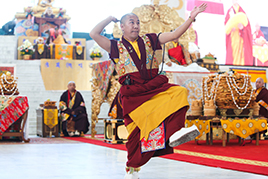
37th Kagyu Monlam Schedule
Tibetan / English / Chinese • French • German • Indonesian • Korean • Polish • Russian • Spanish • Vietnamese
Dharma Teachings
 Meditation Instructions
Meditation Instructions
Recorded during the 37th Kagyu Monlam, Bodhgaya, India. January 28-30, 2020.

